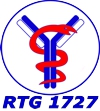MD TP45: Analysis of target antigens of patients with pemphigoid diseases with autoantibody binding to the dermal side of human split skin in indirect immunofluorescence using a new biochip mosaic
An important screening test for serum autoantibodies in pemphigoid diseases is indirect immunofluorescence on human salt-split skin. The majority of patients with pemphigoid diseases exhibit autoantibodies binding to the epidermal side of the artificial splits targeting mainly BP180, BP230 and α6β4 integrin. The remainder of patients (10%) with pemphigoid diseases display autoantibodies labelling the dermal side of the blister. In these patients, type VII collagen (epidermolysis bullosa acquisita), laminin 332 (anti-laminin 332 mucous membrane pemphigoid) and the 200 kDa p200 protein/laminin γ1 (anti-p200/ laminin γ1 pemphigoid) were identified as target antigens. The project focuses on a methodical research of the binding properties found within these patients, by using a new biochip which utilizes recombinant target antigens as a substrate in an indirect immunofluorescent based test. The new biochip mosaic contains HEK293 cells expressing the NC1-domain of type VII collagen, the laminin 332 heterotrimer and laminin γ1, respectively, on the cell surface to enable a serological analysis of the presented autoantibodies.
We will evaluate 400 sera of patients with autoantibodies binding to the blister floor, 200 consecutive sera from the serum bank of the dermatology clinic and 200 from a multicentre study with positive results in the direct immunofluorescence test. For the control group we will use 150 sera of patients with pemphigoid diseases who show epidermal binding properties, 50 sera of patients with pemphigus disease and 50 samples from healthy blood donors.

- Projects
- Projects
- Associated projects
- MD projects
- Associated MD projects
- Concluded projects
- Concluded TP
- Concluded Ass.TP
- Concluded MD TP
- MD TP1 - Ig Glycolysation
- MD TP2 - Immunoprivilege
- MD TP3 - ANA antibodies
- MD TP4 - Autoantibody prevalence
- MD TP5 - Treatment of EBA
- MD TP6 - Autoantibody-induced tissue injury
- MD TP7 - Neutrophil signalling
- MD TP7b - IgG-IC-induced signalling
- MD TP8 - The role of IL-33 and its receptor ST2
- MD TP9 - Detection of antigen-specific B cells
- MD TP9b - Detection of antigen-specific B cells in BP
- MD TP10 - Old drugs to block T cells
- MD TP10b - Combination of T cell inhibitory compounds
- MD TP10c - T cell inhibitory compounds (in vivo)
- MD TP11 - Identification of "genetic biomarkers"
- MD TP12 - Combinations of B cell modulatory compounds
- MD TP13 - TREM1 in cutaneous inflammation
- MD TP14 - Signaling in PV
- MD TP15 - Autoantibodies in relatives
- MD TP16 - Drug-induced pemphigoid
- MD TP17 - Keratinocyte lipid mediators
- MD TP18 - Neutrophils + IL-17A-Inhibition
- MD TP19 - C5aR-Inhibition
- MD TP20 - IgG-Subclasses
- MD TP21 - NF-kB in EBA
- MD TP22 - Biochip Mosaics in AIBD
- MD TP23 - Diagnostic Techniques on AIBD
- MD TP24 - Anti-stimulatory effects on Neutrophil-signaling
- MD TP25 - Phage library on systemic scleroderma
- MD TP26 - New EBA-scoring sytem
- MD TP27 - Neutrophil signaling-pathway inhibition
- MD TP28 - Inhibition of Keratinocytes
- MD TP29 - Monoclonal antibodies in EBA
- MD TP30 - Enhancing vaccinations under Immunosuppression
- MD TP31 - Non-desmoglein autoantibodies in PV
- MD TP32 - Neutrophil adhesion
- MD TP33 - MicroRNA-21 in BP
- MD TP34 - PI3K-subunits in EBA
- MD TP35 - Signaling cascade inhibition in EBA
- MD TP36 - Signaling cascades in keratinocytes
- MD TP37 - AT1R-antibodies
- MD TP38 - Cell migration regulation
- MD TP39 - mACh-Receptors in systemic sclerosis
- MD TP40 - Hair and EBA
- MD TP41 - CMV-specific T cells
- MD TP42 - Necroptosis in GPA
- MD TP43 - Neutrophils and NETs
- MD TP44 - Mitochondrial genome in AIBD
- MD TP45 - Target antigens in pemphgoid diseases
- MD TP46 - Alpha-adrenoceptors in Raynaud´s phenomenon
- MD TP47 - T cell-receptor-sequences in autoimmune skin diseases
- MD TP48 - Epitope specificity and glycolization
- MD TP49 - Inhibition of keratinocyte-dissociation
- MD TP50 - Transcriptome profile of endothelial cells induced by autoantibodies targeting AT1R/ETAR in systemic sclerosis
- MD TP52 - Expression of B4GALT1 and ST6GAL1 ....
- MD TP54 - Reactivity of serum antibodies ....
- MD TP55 - Identification of potential therapeutics .....
- MD TP56 - Validation of the inhibition of different signalling pathways ...
- MD TP57 - Inhibition of IFN-γ as therapy for epidermolysis bullosa acquisita
- MD TP58 - Characterization of immunoglobulin G subclass distribution ...
- MD TP59 - Development of an experimental pemphigus vulgaris model in adult mice
- MD TP60 - Interactions between GPCR and anti-GPCR IgG autoantibodies...
- MD TP61 - Glycosyltransferases B4GALT1 and ST6GAL1 in...
- MD TP62 - Sensitivity of diagnostic test systems in dermatitis herpetiformis Duhring
- Concluded Ass. MD TP






